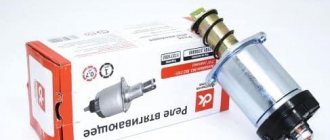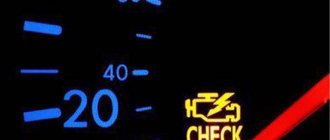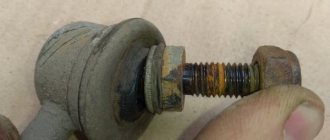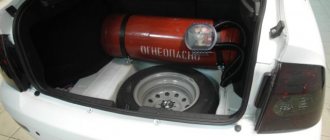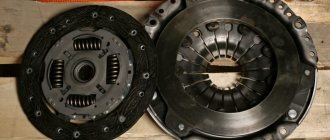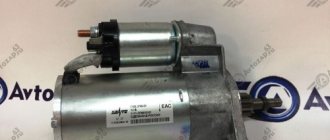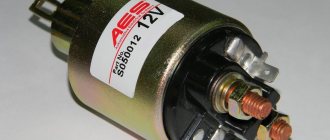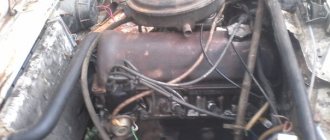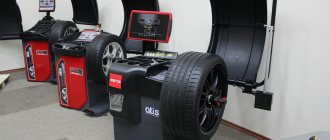A starter is a device that starts the engine when the key is turned in the ignition or the start button is pressed. During operation, the device wears out a lot and ultimately fails.
It is generally accepted that unsuccessful attempts to start the engine are the consequences of a discharged battery. In some cases this is true, and the battery is often discharged due to a malfunction of the generator. However, most often the problem lies with the starter.
When it fails, there are several warning signs.
First news of the problem
It is quite possible that the cause may be damaged wiring or a faulty ignition switch.
If when you turn the key in the ignition switch you hear a click and nothing else happens, then the reason for this may be a discharged battery or the starter itself.
I will not describe the device and principle of operation of the starter; full information on this topic can be studied in the picture below.
Problems with the starting system can be caused by poor maintenance or simply wear and tear. With many modern vehicles equipped with a start/stop button, the load on the starter and battery has increased significantly.
Other symptoms of malfunctions
The electric motor has difficulty turning the crankshaft of the car engine. You can hear it by the sound, it begins to “moo” and barely turn the flywheel. This is the cause of either a discharged battery or worn out contact brushes of the electric motor.
When you tried to start the car engine, you heard a click, and then silence. After this, the lights on the dashboard began to glow at full incandescence. The reason for this starter malfunction is trivial - poor contact at the battery terminals.
To Contents...
The starter continues to operate after the engine starts
When the engine starts and you release the ignition key, the power supply to the traction relay stops and the bendix returns to its original position under the action of a spring.
If power continues to flow, this most likely indicates soldering of the main contacts in the solenoid.
The first thing to do is exclude the battery and generator from the list of possible causes.
Don't forget that the starter only works properly if the battery is fully (or sufficiently) charged.
Therefore, if the engine does not start, try starting it from an external power source using special connecting wires or use a jump starter.
After a successful start, it becomes clear that the problem lies in the electrical system.
Bendix failure
The starter clicks, the electric motor rotates, but the crankshaft does not turn
These are signs of a Bendix malfunction. Remember, its gear should rotate freely in one direction, and jam when you try to turn it in the opposite direction?
So, the cylinders that are in the overrunning clutch are not pressed against the outer race and the gear rotates freely in both directions. This means that when it engages with the flywheel, the Bendix cannot turn the crankshaft as it spins.
This is accompanied by the sounds of a running electric motor. It will work at high speeds, since nothing prevents it from spinning up to maximum values. If the bendix has not yet completely “died”, then this sign of malfunction will appear periodically . That is, today the starter started the engine, but an hour later it may not turn the crankshaft, but simply squeak at maximum engine speed.
Starting a car engine is accompanied by a terrible grinding noise.
This could be for two reasons:
- The Bendix did not engage the flywheel completely.
- The teeth on the gear or flywheel are worn.
In the first case, the bendix jams on the starter shaft. It is enough to disassemble it, clean the splines along which it moves, and lubricate them.
In the second case, only replacing the gear or flywheel. By the way, this malfunction does not appear immediately, but due to long-term use of the starter with poor engagement of the bendix and flywheel. That is, because of the first reason.
To Contents...
Last attempt to start the starter
When trying to turn the key in the ignition switch, one faint click is heard. There is one trick that can help. It may sound strange, but if you press down on the back of the starter while turning the ignition key, the engine can start.
After asking a friend to turn the key in the ignition, press the starter with a hammer. Even if the engine starts, the starter should be repaired or replaced immediately.
How to determine if the starter is faulty
Most starter breakdowns are quite easily identified by characteristic signs.
For convenience, the most common unit malfunctions and their symptoms are summarized in the table:
| Symptoms of malfunction | The essence of the problem | Reason for appearance |
| The starter turns properly, but the flywheel stays in place | Bendix planetary gear broke | Mechanism bushings are worn out |
| Spring doesn't work | The spring has weakened | |
| Gear teeth and flywheel ring do not mesh | The teeth are worn out | |
| The starter clicks but doesn't turn over | No mass | The ground cable is broken or the contact is oxidized |
| Insufficient current | The battery is not charged or does not gain capacity | |
| No contact between rotor ring and brushes | Brush wear | |
| Solenoid relay does not work | Burnt contacts or burnt winding | |
| The anchor is not working | Short circuit in the winding, the contact ring is worn out or burnt out, the lamins pass current | |
| Starter barely turns | There is wear on the bushings | Deterioration from time or dirt |
| Short circuit in the brush assembly | The part is covered with graphite dust from brushes | |
| The turns of the stator winding are punched to ground | Corrosion, the rotor rubs against the winding | |
| Interturn closure of the winding on the armature | The insulation is damaged due to corrosion or the armature touching the stator winding | |
| A sharp grinding noise when trying to turn on the starter | Scored flywheel ring or broken teeth | Natural wear, abrasive material on the gears, corrosion, defective part |
| Bendix bushing worn out | ||
| The starter works on a cold engine, but after warming up you can hear clicks. | Solenoid relay is faulty | Relay core stuck |
| Sagging of the springs pressing the brushes | Natural fatigue or overheating of the starter when starting | |
| Development on bushings | Natural wear or contact with sand or other abrasives on the walls | |
| Burnt nickels of contacts | Natural wear and tear, the starter takes too long to start | |
| There is no minus on the brush assembly | Contact oxidation |
The starter turns sluggishly
As a rule, low voltage in the on-board network is to blame. So start by checking.
If everything is normal with the battery, and the voltage on it is 12 V or more, check the condition of the terminals. The most common cause is poor contact. Clean the terminals thoroughly from oxides, lubricate them with grease (litol, grease, etc.) and secure well. You shouldn’t pull the terminals too hard, as this will deform the battery terminals, which are made of lead, and the wire terminals themselves, which are now made from something completely unknown.
Check if there is ground on the body and engine. To do this, simply select the resistance measurement mode on the multimeter and measure it between the negative terminal of the battery and the motor, and then between the terminal and some unpainted bolt on the body. The resistance should be close to zero. If this is not the case, inspect the attachment of the negative wire to the engine and check the integrity of the “pigtail” connecting the engine and the body. It is attached to the clutch bell.
It is very difficult to find a similar starter for Japanese and American cars.
The car only starts if the engine is not warmed up. About a third of such cases are associated with a faulty battery, another third are associated with changes in the properties of conductors or contacts (the so-called parasitic resistance). The remaining third of cases are a problem in the starter. Often this type of malfunction is associated with a malfunction of the brushes, contacts or plates of the traction relay. Everyone knows that when heated, metal expands - this is exactly what happens when the engine and its parts warm up. The main reason for changes in starter contacts is heat, which causes an increase in the size of starter parts.
STARTER DEVICE
Rice. 1 Old style starter
Currently, cars are equipped with 2 types of starters, let’s call them conventionally:
- old-style starter (Fig. 1);
- a new type starter (Fig. 2).
These starters have two significant differences:
- The stator of the first starter has windings to which voltage is applied, but on the “new” starter, permanent magnets are installed instead. To compensate for the reduced electromagnetic interaction between the stator and the armature of the 2nd starter, a current passes through the armature windings, which is more than twice as strong as the current in the armature windings of the 1st starter. This solution made it possible to reduce the starter housing and increase the speed of rotation of the armature;
- due to the fact that the moment of force created by the armature of the 2nd starter has decreased, rotation is transmitted to the bendix through a reduction gearbox, and not directly, as on the first starter.
Rice. 2 Cutaway view of a new starter
The operating principle of both devices is absolutely identical. To more clearly visualize the operation of the mechanism, we will use a schematic representation of the starter solenoid relay - in principle they are all the same. The sequence of operation of the starter can be represented step by step as follows:
- – while the starter circuit is open, only the positive power wire from the battery is connected, but no current flows; the bolt to which the wire is screwed (indicated in orange) is installed in the solenoid relay cover, made of dielectric;
- You turn the ignition key to “start”, the starter relay is activated;
- the current from the starter relay is supplied to the retractor winding;
- the retractor relay core (blue) under the influence of a magnetic field moves towards the cover, overcoming the resistance of the return spring, and presses the contact plate (orange) to the bolt heads, creating electrical contact between them;
Rice. 3 Schematic illustration of the starter solenoid relay
- in parallel with this, a holding winding is connected to ensure uninterrupted operation of the starter, and the retractor relay core acts on the fork (lever) connected to the bendix, pushing it towards the flywheel. When moving forward, the Bendix “twists” so that the contact of its teeth with the teeth of the flywheel occurs “softly”, without impact;
- current from the bottom bolt flows to the starter windings. In the case of starter No. 1 - through the stator and armature, in starter No. 2 - only through the armature. In parallel with this, current flows through the brushes to the armature windings.
Everything happens at the same time - pushing and twisting the bendix and rotating the armature. When the relay opens, the coils of the retractor relay “release” the core, and it, under the influence of the return spring, returns the bendix to its place, and the armature stops, rotating for some time by inertia. If the starter of your car does not have a protective cover for the Bendix on the front cover with an armature plain bearing (bushing), then this is not important - in such cases the bushing is pressed into the gearbox clutch housing. Let's start describing common starter malfunctions, dividing them into breakdowns in the electrical and mechanical components of the unit.
Determining a fault using a tester
The starter does not rotate the flywheel or does so slowly. Obviously, the torsional force must be sufficient to start the internal combustion engine. If this does not happen, it is recommended to start checking the electrical circuit.
The essence of ideal circuit operation comes down to the following:
- All contacts, including ground, must be secured securely and tightly;
- The battery must be well charged;
- The wire from the traction wire must be intact and have good contact;
- All ignition switch contacts must function properly;
- The cable going from the battery to the starter must not be damaged and loosely fixed.
Thus, it is worth paying attention to the problems listed above if the starter-engine connection is faulty.
How to test a battery starter
Among the purely electrical problems of the starter, it is customary to highlight the following:
- Failure of traction.
- Armature commutator wear.
- Weakening of the brush group.
Obviously, various measuring instruments come to the aid of a person if problems related to electricity arise. As a rule, experienced motorists always keep a tester in their car, which makes it easy to determine a particular starter malfunction.
If there is no tester, then a regular 12-volt light bulb can easily perform its functions.
Below is an algorithm for conducting a test using a 12 volt indicator.
- Connect one end of the light bulb to the starter brush assembly holder;
- The other end of the homemade tester is on the body.
Diagnostics are carried out: if the light comes on, then the brush assembly needs to be replaced, there are obvious breakdowns.
How does a starter work?
To test the brushes with an ohmmeter, you need to measure the resistance between the brushes and the main plate. If the value is not equal to infinity, the brushes need to be replaced.
Worn starter bushings or bearings
This malfunction does not occur “suddenly”, but makes itself felt long ago: more and more often, the car does not want to start the first time, the starter does not turn, or it turns, but not so intensely, although the battery shows normal charging. The problem occurs more often when the engine is hot, and when the engine has been left standing overnight and cooled down -. To determine the misalignment of worn bushings, the assembly must be removed and disassembled. Along the way, several more reasons may come to light why the starter is “silent”: such as worn brushes, burnt lamellas or desoldering.
Armature commutator wear
The starter makes strange noises
Crackling or grinding noise when starting the engine
This sound occurs when the starter gear does not fully engage with the flywheel ring teeth. There may be several reasons, and most of them can be easily eliminated.
- The connection between the starter and the clutch bell is loose. It happens. Just try to shake the starter by hand; if it does not fit tightly, tighten the nuts securing it to the required torque and try to start the engine. Most likely, the scary sounds will disappear.
- Insufficient starter sliding clutch movement. The gear just doesn't fit into place. Usually the culprit is a mud-covered shaft. To restore functionality from the car. Next, clean the shaft and lubricate it with good grease. Check the movement of the gear; there should be no jamming.
- The fork moving the sliding clutch may be to blame. It happens that it breaks or becomes deformed, although this is rare. In both cases, the plug needs to be replaced.
- The flywheel crown is corroded. You can easily see this problem by removing the starter and simply looking into the hole in the clutch bell. There are several solutions to the problem: replacing the flywheel, replacing the crown (the old one is knocked down, and the new one is heated and pressed hot onto the flywheel), you can try turning the old crown over (we heat the crown and press it off the flywheel, heat it again and press it on the reverse side).
The fastening of the starter retractor to the housing has become loose. The result is incomplete movement of the gear. Tighten the fasteners.
Screech. In this case, the engine sometimes turns over a little, but not enough to start.
As a rule, this behavior indicates that you need to get to know Bendix better.
For those who do not fully understand what this is, let us explain.
Bendix is nothing more than an overrunning clutch. Its meaning is that when the starter rotates, it rigidly connects the drive gear to the electric motor shaft, and at the moment when the engine starts and its speed increases, it begins to slip, preventing the internal combustion engine from rotating the starter motor. A similar thing is present in the rear wheel of a bicycle; it makes a characteristic chirping sound when coasting. That is, it is not the drive gear itself, but precisely the thing to which this gear is attached.
This part can be removed quite easily, but it will get very dirty. Although, if you removed the starter, you should no longer worry about this.
- Press the thrust bushing off the axle.
- Use a screwdriver to pry it off and remove the spring retaining ring.
- Remove the bendix and gear assembly.
- We replace it with a new one and put everything back together in reverse order.
That's all the faults.
Problems with the solenoid relay
Sometimes, when the ignition is turned on, only this relay is immediately activated, and accordingly, the circuit remains open. You can try closing the traction contacts, but this does not help in all cases. The appearance of extraneous crunching noise in the engine compartment area is evidence of a malfunction of the Bendix. This element is made in the form of a small gear and is located on the rotor shaft. The solenoid relay is activated when voltage is applied to it, controlling the movement of the bendix, causing it to engage the flywheel. Wear of this part makes it impossible to perform this procedure, since its worn out parts cannot be aggregated with the teeth of the flywheel, and this causes a strong crunch.
The stator or rotor windings are shorted
If the starter not only does not turn the engine (you can’t hear the sound of turning), but also emits a smell of burning insulation, it most likely burned out due to a short circuit. The main “enemy” of the electric starter is overheating, which destroys the varnish coating of the windings. Old-style gearless devices (with an excitation winding) especially suffer from overheating. Exposed wires always threaten a short circuit. An interturn short circuit of the armature (or a breakdown to ground) is indicated by a deterioration in the efficiency of the electric motor: the flywheel turns slowly, with great “reluctance”. You can check the stator and armature only after removal - visually, for a wire break, with a “continuity test”, using load clamps.
When can you move the starter from one car to another?
If the starter manufacturer switched to producing geared models, then direct drive starters can be replaced with geared ones, and vice versa. In this case, it is possible to select even several replacement options for European foreign cars. Starters from different manufacturers that are installed on the same model of machine can be considered analogues.
Today there is a very wide variety of starters produced, and they differ significantly, even though they are outwardly similar. So, they differ in the offset of the bendix, the seating dimensions, the number of teeth on the gears, the size of the teeth, and so on.

